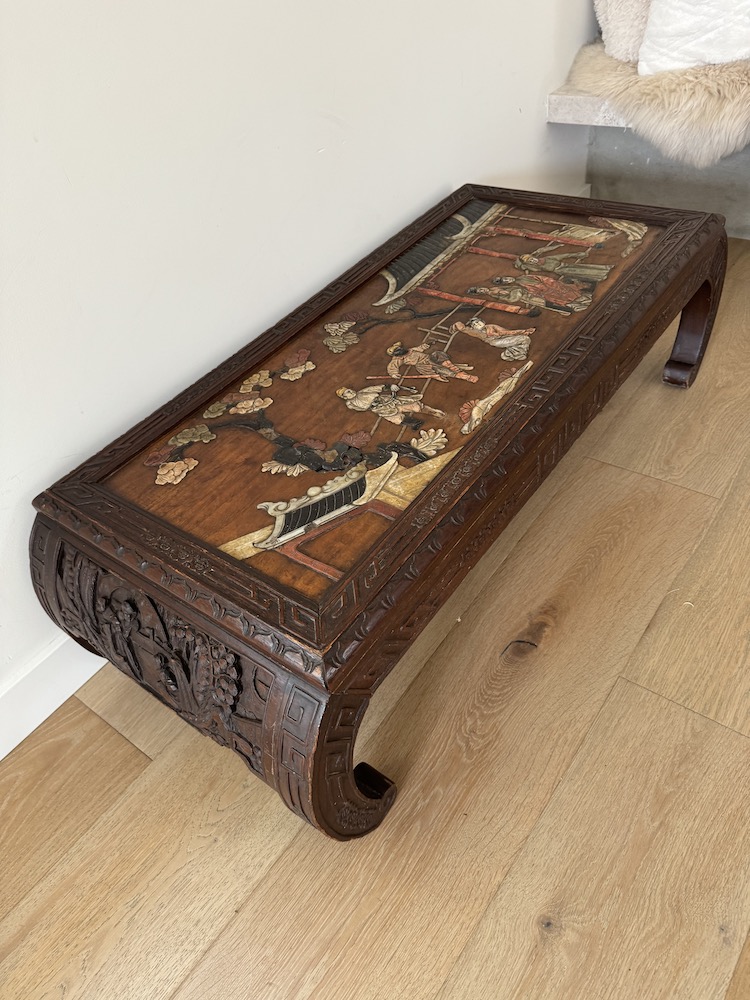Chinoiserie Coffee Table

RH has a Chinese style coffee table with a startling scene of ancient Chinese Court life, composed of applied carved semi-precious stone figures. Two of the six figures are battling: there’s a man wielding a bamboo stick and another kneeling, the other figures look on from an elegant pagoda. RH has always wondered about this table, what it portrays, and why his British grandmother owned such a piece.
Through the history of the 18th, 19th, and 20th cent. the style called Chinoiserie has been avidly collected, and, in turn, disliked. The reason for “dislike” may be twofold: often the style is a stereotype of the culture, and secondly, the style is ornate, glamorous, and whimsical (not the LOOK today).
Chinoiserie’s history began in 1742 when the British Ambassador to China, Lord Cathcart, returned with a shipload of furniture. By 1760, the style had influenced architecture, porcelain design, furniture, colors, and wallpaper. As early as 1498, the Empire of China fascinated Europe, as Portuguese explorer Vasco da Gama had opened a sea route to the west coast of India by way of the Cape of Good Hope. By 1672, The Dutch East India Company established trade between Canton (Guangzhou), Beijing, and European ports. The Company sponsored Johan Nieuhof (1618-1672) on a 1,500-mile mission to China; he subsequently published an account of his years of travels in An Embassy from the East India Company. The book, containing 150 copper plate etchings of “Pagan” Pagodas et al was translated into German, French, and Latin. In 1672 the Company opened a trading post in Taiwan, holding a monopoly on all Chinese trade till 1833. The main trade was in tea, which led to Chinese porcelain becoming a much sought after commodity (Europe did not have the ‘formula’ to make porcelain till Ehrenfried Walther von Tschirnhaus’ discovery of the process, and the start of regular production of European porcelain by the royal factory at Meissen in 1710). Because tea services were in vogue, so were tea tables. These objects were designed in China for the European market, or in London for the English market in the Chinoiserie taste.
Melding Chinese and European styles in design occurred as early as 1754 when Thomas Chippendale published his Gentleman’s and Cabinet Maker’s Director, a pattern book of furniture in the Gothic, Chinese, and European Rococo tastes. The influence of such a mix is seen on RH’s coffee table: firstly, RH’s table is in the form of a coffee table, which is NOT a Chinese style, and the scene portrayed is NOT in the European taste (the scene dates from the mid-19th century, likely cut from a Coromandel screen); and the 20th century support armature and legs are Chinese style made for the British market.
In three eras in decorative art and design history we find a rage for Chinoiserie. In the late 18th century, society saw the apex of the style under the Prince Regent (the future George IV), who commissioned an estate with magnificent gardens called the Royal Pavilion (1810-1820). The second era occurred in the late 19th century – the Aesthetic Movement – when Japan was ‘opened’ by Commodore Perry and Asian porcelain and design became widely coveted, which calls to mind Oscar Wilde’s quote from that period, “I hope to live up to my Blue and White china.” The third renaissance, in the roaring ‘20s, saw the birth of RH’s table, when Chinese Coromandel screens were beloved by the fashionable, such as Coco Chanel (1883-1971), who owned 32 multipaneled screens at her rooms at 31 Rue Cambon, Paris. A Coromandel screen is a type of lacquerware that has many coats of lacquer applied, sculpted, or overlaid with figures created by “kuan cai,” incised colored materials such as stone, gold, or mother of pearl in red or black lacquer. The screens are called Coromandel because they were shipped from China to Europe via the Coromandel coast of south-east India, where European trading companies, including the The Dutch East India Company, had their bases.
Suddenly Art Deco Europe felt a need to paint rooms Chinese Red and Black, to hang huge, gilded mirrors, to cover walls and upholstery with dramatic Asian patterns, and to come for cocktails in Chinese silk-embroidered coats and sporting bowl-cut bobs such as those worn by Flapper gals.
What does this scene of two men, one being beaten with a bamboo rod, and one doing the beating, MEAN? Under traditional Chinese law going back to 907, whipping with a bamboo stick was one of the recommended punishments; the tradition of 10 to 50 lashes (for a debt, for example) was accepted practice into the late 19th century. As mentioned, the scene is cut from a much older screen, which would have contained a narrative of upper-class Chinese Court life. The value of the table is $400-500 (as today, Chinoiserie style is NOT in favor).







You must be logged in to post a comment.